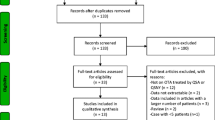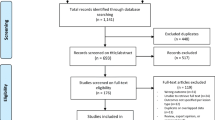Abstract
The purpose of this study was to retrospectively analyze the clinical characteristics of treating nevus of Ota by Q-switched Nd:YAG laser in Laser Cosmetology Center of Department of Dermatology, the Second Hospital, Xi’an Jiaotong University. The data of 1168 patients of nevus of Ota were analyzed retrospectively, which included the correlation among lesion color, treatment sessions, sex, age, lesion types, and effect. The Q-switched (QS) Nd:YAG laser system had a higher number of treatment sessions which were positively associated with a better response to treatment. Other variables, including gender, age, the categorization of the lesion according to Tanino’s classification, and the color of the lesion, were not associated with the response to treatment. The treatment of nevus of Ota with QS Nd:YAG laser is safe and effective, with rare complications.


Similar content being viewed by others
References
Saha A, Bandyopadhyay D (2014) Nevus of Ota. Indian Pediatr 51:510
Zhang Q, Tan C, Jiang P, Yang G (2017) Clinical profile and triggering factors for acquired, bilateral nevus of Ota-like macules. Cutan Ocul Toxicol 25:1–14. doi: https://doi.org/10.1080/15569527.2017.1287191. [Epub ahead of print]
Hosaka Y, Onizuka T, Ichinose M, Yoshimoto S, Okubo F, Hori S, Keyama A (1995) Treatment of nevus Ota by liquid nitrogen cryotherapy. Plast Reconstr Surg 95:703–711
Kumagai N, Fukushi S, Matsuzaki K, Ishida H (1995) Treatment of nevus of Ota with autologous-cultured epithelium grafting combined with dermabrasion. Ann Plast Surg 34:180–186
Aurangabadkar S (2008) Q-switched Nd:YAG laser treatment of nevus of Ota: an Indian study of 50 patients. J Cutan Aesthet Surg 1:80–84
Hata Y, Matsuka K, Ito O, Matsuda H, Furuichi H, Ishizu N, Konstantinos A (1996) Treatment of nevus of Ota: combined skin abrasion and carbon dioxide snow method. Plast Reconstr Surg 97:544–554
Tse Y, Levine VJ, McClain SA, Ashinoff R (1994) The removal of cutaneous pigmented lesions with the Q-switched ruby laser and the Q-switched neodymium: yttrium-aluminum-garnet laser. A comparative study. J Dermatol Surg Oncol 20:795–800
Levin MK, Ng E, Bae YS, Brauer JA, Geronemus RG (2016) Treatment of pigmentary disorders in patients with skin of color with a novel 755 nm picosecond, Q-switched ruby, and Q-switched Nd:YAG nanosecond lasers: a retrospective photographic review. Lasers Surg Med 48:181–187
Felton SJ, Al-Niaimi F, Ferguson JE, Madan V (2014) Our perspective of the treatment of naevus of Ota with 1,064-, 755- and 532-nm wavelength lasers. Lasers Med Sci 29:1745–1749
Tanino H (1939) Naevus fusco-caeruleus ophthalmomaxillaris (Ota). Jpn J Dermatol 46:369
Ota M, Tamino H (1939) A variety of nevus frequently encountered in Japan, nevus usco-caeruleus ophthalmomaxillaris and its relation to pigmentary change in the eye. Tokyo Med J 63:1242–1244
Redkar NN, Rawat KJ, Warrier S, Jena A (2016) Nevus of Ota. J Assoc Phys India 64:76–88
Lowe NJ, Wieder JM, Sawcer D, Burrows P, Chalet MI (1993) Nevus of Ota: treatment with high energy fluences of the Q-switched ruby laser. J Am Acad Dermatol 29(6):997–1001
Shah VV, Bray FN, Aldahan AS, Mlacker S, Nouri K (2016) Lasers and nevus of Ota: a comprehensive review. Lasers Med Sci 31:179–185
Liu J, Ma YP, Ma XG, Chen JZ, Sun Y, Xu HH, Gao XH, Chen HD, Li YH (2011) A retrospective study of q-switched alexandrite laser in treating nevus of Ota. Dermatol Surg 37:1480–1485
Seo HM, Choi CW, Kim WS (2015) Beneficial effects of early treatment of nevus of Ota with low-fluence 1,064-nm Q-switched Nd:YAG laser. Dermatol Surg 41:142–148
Rathi SK (2002) The fundus in oculodermalmelanocytosis. Is this a new observation? Clin Exp Optom 86:183–186
Author information
Authors and Affiliations
Corresponding authors
Ethics declarations
Ethical approval
All procedures performed in studies involving human participants were in accordance with the ethical standards of the institutional and/or national research committee and with the 1964 Helsinki Declaration and its later amendments or comparable ethical standards.
Conflict of interest
The authors declare that they have no conflict of interest.
Informed consent
Informed consent was obtained from all individual participants included in the study.
Rights and permissions
About this article
Cite this article
Yan, L., Di, L., Weihua, W. et al. A study on the clinical characteristics of treating nevus of Ota by Q-switched Nd:YAG laser. Lasers Med Sci 33, 89–93 (2018). https://doi.org/10.1007/s10103-017-2342-3
Received:
Accepted:
Published:
Issue Date:
DOI: https://doi.org/10.1007/s10103-017-2342-3




